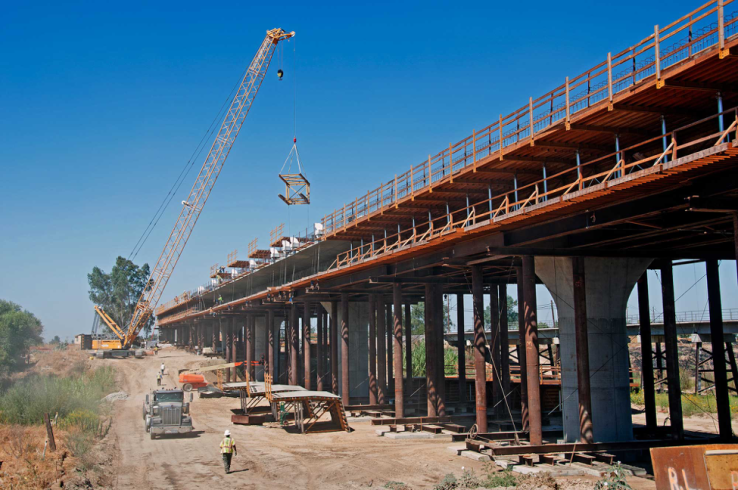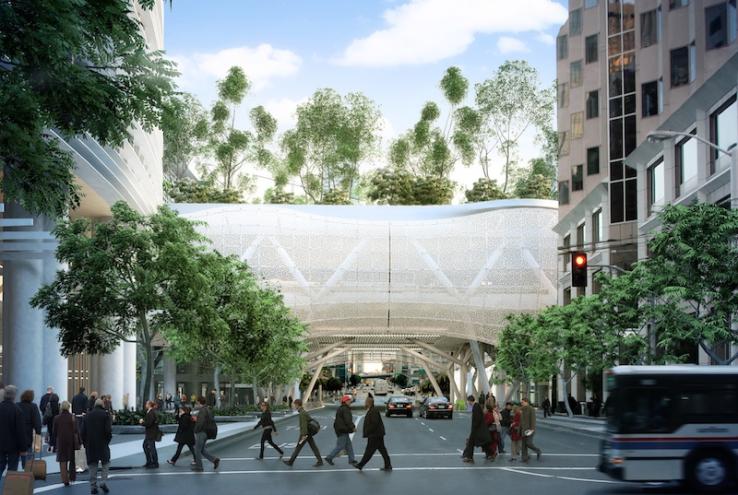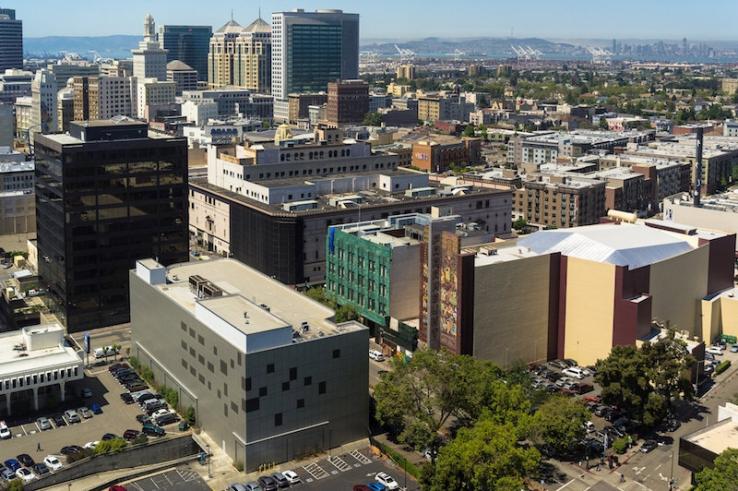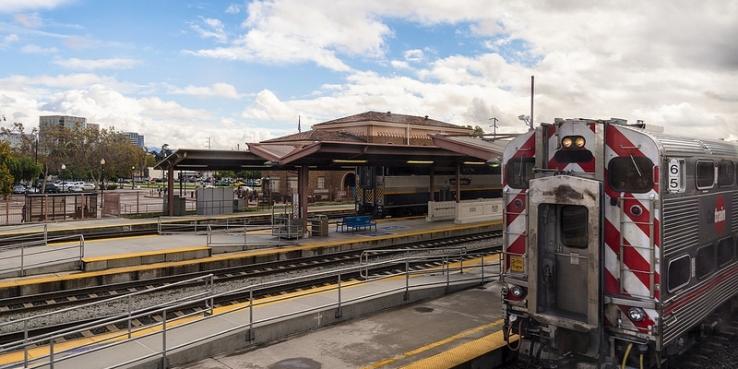With so many transportation agencies in the Bay Area, different entities often end up planning and building pieces of the same project. That’s happening right now on a grand scale: There are no less than five megaprojects taking place between San Jose and Oakland. When complete, they should add up to a fast, frequent, one-seat train ride connecting downtown San Jose, the central cities of Silicon Valley, SFO, downtown San Francisco and downtown Oakland.
The way we see it, these five projects — totaling well-over $20 billion — are all part of one super-megaproject that should be envisioned and planned in coordination. SPUR has been involved in each of these projects, and because it’s our job to care about them individually, it’s also our job to tie these pieces together and urge decision-makers to do the same. If the Bay Area is to remain a competitive player in the global economy, we need to keep up with the kinds of transportation systems the rest of the world is building.
Here are the five mega-projects that could, if planned right, add up to much more than the sum of their parts.
1. High-Speed Rail and Caltrain Electrification
In 2011, the California High-Speed Rail Authority (CAHSR) and Caltrain agreed to share the same right-of way between San Jose’s Diridon Station and San Francisco’s Transbay Transit Center. This agreement is referred to as the “blended system.” Shared-use high-speed rail systems are common in many regions, where higher-speed trains share tracks with slower trains or freight trains. It will allow high-speed rail and Caltrain to share expenses, maintenance, train systems such as power and signals, even trains — and also having a smaller rail footprint through urban areas. The challenge is tightly coordinating services without introducing delays and bottlenecks. Service in the blended system could start as early as 2026, when construction at Diridon Station is scheduled to be completed. The high-speed rail system already has over 119 miles under construction in the San Joaquin Valley.

Currently, CAHSR is analyzing the environmental impacts of the project and studying a set of options for the physical infrastructure of the blended system. Caltrain is also implementing its plan to switch from diesel to electric power. Designing a successful blended system will require each of the three shared stations to be planned in an integrated way. (The Transbay Transit Center is nearly completed, meanwhile Millbrae and Diridon stations are currently being planned. San Francisco’s 4th and King Caltrain station may be a temporary terminal for high-speed rail.) Also, changes to platforms, tracks, grade separations, train control systems and maintenance facilities will need to be coordinated.
- SPUR’s Caltrain Corridor Vision Plan includes comprehensive recommendations for blending the two systems and increasing capacity to meet future demand.
- We recently wrote about the importance of Caltrain’s Business Plan.
- We are researching how cities can get the most benefit from high-speed rail and will be releasing a report on the land use and economic development opportunity of high-speed rail, particularly in the San Joaquin Valley.
- Stay tuned for our coverage on key decisions for the blended system and our take on the forthcoming proposed alignments for the Merced-to-San Jose segment of high-speed rail.
2. Diridon Station Redevelopment
One of the region’s largest growth opportunities near rail is Diridon Station, in the center of San Jose. Multiple transportation megaprojects are currently coming together at Diridon: bringing BART to San Jose, bringing high-speed rail to San Jose, electrifying Caltrain, creating a transit connection to the Mineta San Jose International Airport, rethinking the bus terminal for both public and private use, and expanding Capitol Corridor and ACE service. All told, the number of daily passengers is expected grow from 17,466 in 2016 to over 138,000 in 2040, a seven-fold increase.
Projected 2040 Passenger Boardings and Transfers at Diridon Station

The design questions under consideration today include how high-speed rail and BART should come into the station (e.g., should high-speed rail be elevated or at-grade?), what physical structure will bring all of the transportation modes together, and how much parking is really needed.
But some of the most important questions aren’t being asked or answered — a symptom of the fragmentation that megaprojects often face. These questions include: What type of entity do we need to successfully develop a vision and deliver the many different rail and land use projects that constitute the Diridon megaproject? Should high-speed rail and Caltrain share tracks and platforms at Diridon? Are there projects outside of the immediate Diridon Station area that will help make the station function better, such as improving light rail to and from the station?
SPUR has launched a multi-year initiative on remaking Diridon Station and the 240 acres around it called Next Stop: Diridon. As part of this effort:
- We held a public exhibition on lessons from stations in other regions.
- We are leading a delegation of elected officials and key decision-makers to Europe to study urban transportation and city-building projects.
- We recently shared our top principles for remaking Diridon and our ideas on how to get it right.
3. Downtown San Francisco Rail Extension
The Caltrain Downtown Rail Extension is a planned 1.3-mile underground tunnel that would extend Caltrain service from its current northern terminus at San Francisco’s Fourth and King streets to the new Transbay Transit Center at First and Mission streets. This tunnel would also be used by high-speed rail.
The downtown extension would shorten trip times between Millbrae and downtown San Francisco by 15 to 20 minutes (compared to transferring to BART) and offer a one-seat Caltrain ride between Market Street and the cities along the Caltrain Corridor. In the future, this train could extend across San Francisco Bay and connect with the rail network in the East Bay.
A significant majority of San Francisco voters (69 percent) approved the tunnel and the new Transbay Transit Center in 1999. Although the transit center is nearly complete, political will to finance and build the expensive urban tunnel has been tepid until recently.

- The San Francisco Planning Department is currently re-evaluating alignment options for the downtown extension, looking for simpler construction, more street connectivity, better rail and street transit service and other benefits. The Railyard Alternatives and I-280 Boulevard Feasibility Study will publish findings this year; stay tuned for SPUR’s analysis.
- SPUR discussed ideas for the downtown extension and for turning I-280 into a boulevard in 2013.
4. New Transbay Rail Crossing
SPUR has long identified the need for a second rail crossing between San Francisco and the East Bay. We have identified five main reasons the region needs a new rail crossing, in addition to the BART link we already have: We are running out of space on transbay transit service for many more passengers; our system is not reliable; we are vulnerable to disasters and other disruptions; we are failing to meet our policy goals; and we don’t have all-night rail. There is one big question that needs an answer: Should the new crossing be designed for BART trains or should it be built with standard rail tracks (used by Caltrain, Capitol Corridor and high-speed rail)? Or should we build both types of crossings? While BART has begun studying a second BART crossing, there is no clear entity charged with planning a new standard rail crossing.
While we needed a second transbay rail crossing yesterday, this project will take years to design and build. Finishing a new rail crossing will enable the Transbay Transit Center to become a “through station” (with much more capacity) and eventually, connect the Peninsula with the East Bay, Sacramento and beyond. MTC’s Core Capacity Transit Study looked at both the need for a new crossing and the places where a tunnel could land on each side of the Bay.
- For more on a new Transbay rail crossing, read SPUR’s Designing the Bay Area’s Second Transbay Rail Crossing.
- See research from a UC Berkeley’s Third Crossing Studio, as well as other crossing ideas at Urban Life Signs.
- Stay tuned to the SPUR blog for coverage of emerging plans for a new crossing.
5. New East Bay Rail Hub
A new rail station in the East Bay, where transbay and East Bay train lines would connect, is the most conceptual of the megaprojects. But without a new station, there is no place for a new transbay train to go. Two big questions are where to connect with the existing BART system and where in downtown Oakland to locate a new hub. One idea, promoted by ConnectOakland, is to turn I-980 into a boulevard and build a train station beneath it, possibly including a new railyard. SPUR explored these ideas in our report A Downtown for Everyone, about the future of downtown Oakland. More ideas can be found at Urban Life Signs. Capitol Corridor’s Vision Plan also explores conceptual ideas for a new station in the Jack London Square area, as well as ways to take trains off of Oakland’s Embarcadero street, where cars, pedestrians, passenger trains and freight trains currently intermingle.

The next megaproject will be upgrading the East Bay’s rail network to handle far more trains. This initiative will be made very complicated by the need to separate passenger rail service from freight trains while solving for major constraints in the network, either in the middle of cities or in tricky conditions such as over rising Bay waters.
And There Are More
A number of related rail projects will be needed to make the most of these five megaprojects. Rail projects under study include Muni light rail extensions (such as extending the Central Subway to Fisherman’s Wharf), service increases for ACE, Altamont Pass rail improvements and a transbay rail crossing at Dumbarton.
The 2018 California State Rail Plan encompasses the megaprojects above and many more across the state. The forthcoming draft plan envisions California’s cities connecting with unified train services (with a single, convenient schedule and ticket) while growing the efficiency of our freight train network and our ports. The value California will see from coordinated schedules and tickets cannot be emphasized enough. A coordinated statewide network like this is needed to keep people and goods moving between California’s cities as we add the next several million people to the state.
Citybuilding, Collaboration and Competition
Without a doubt, these rail and station megaprojects are competing for funding. Proponents of each project are asking for funding from every new pot of money that emerges, including the recently passed SB 1 funding package, a possible bridge toll increase and new sales taxes. Competition is fierce, but the truth is that none of these megaprojects matter unless the others happen, and on a coordinated timeline. Megaprojects are fraught with challenges, but many of them are foreseeable. (We discuss some common megaproject management strategies in Appendix C to the Caltrain Corridor Vision Plan.)
In addition, all of these megaprojects must contend with how they will be affected by sea level rise and climate change. Combining rail’s climate benefits with the need for added housing and density may make these projects even more important; they are not just transit projects but strategies for adapting to climate change, addressing the housing crisis and improving the overall livability of the region.
One thing the Bay Area is doing right is viewing these transportation projects as city-building initiatives. Rather than just plop down a new rail line or tunnel, cities are asking how they can make transportation projects part of their plan for growth, knitting together neighborhoods, growing new businesses, opening new ways of getting around instead of obstructing them.
But coordinating these projects with each other is a separate step, and one we must prioritize. Consider the Bay Area’s experience with the Interstate Highway System: Most funding came from the federal government, but state and local highway departments built the projects. For the most part, the pieces all connect. But in the Bay Area, we have stub ends and missing links. It’s a good thing we didn’t build more freeways through our cities, but we’re left with a semi-functional, irrational highway network.
The lesson is to have the end in mind when planning the parts. We need to treat the current set of megaprojects as if they were one project benefitting many: the cities they run through, the region and the state.
